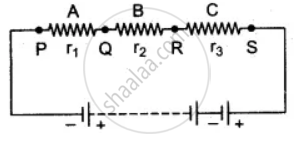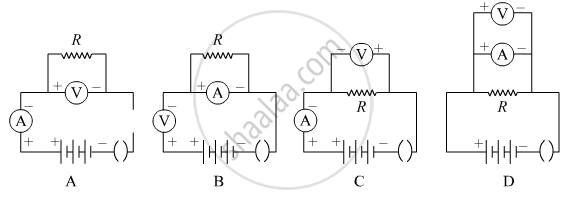Advertisements
Advertisements
Question
Suppose there are three resistors A, B, and C having resistances r1, r2, and r3 respectively. If R represents their equivalent resistance, establish the following relation R = r1 + r2 + r3 when joined in series.
Solution
Let the three resistors be joined in series in given figure.
Let potential at P, Q, R and S are Vp, VQ, VR, and VS respectively and current i flows in the circuit.
Applying Ohm's law,
Vp + VQ = ir1 ...(i)
VQ - VR = ir2 ....(ii)
and VR - VS = ir3 ....(iii)
If the total effective resistance between P and S be R', then the potential difference:
VP - VR = iR' ....(A)

Adding (i), (ii) and (iii)
VP - VQ + VQ - VR + VR - VS = ir1 + ir2 + ir3
or VP - VS = i (r1 + r2 + r3) .... (B)
Comparing (A) and (B), we get
iR' = i (r1 + r2 + r3)
or R' = r1 + r2 + r3
APPEARS IN
RELATED QUESTIONS
How much energy is given to each coulomb of charge passing through a 6 V battery?
What is meant by saying that the electric potential at a point is 1 volt?
Why do electricians wear rubber hand gloves while working with electricity?
Write down the formula which states the relation between potential difference, current, and resistance.
A V-I graph for a nichrome wire is given below. What do you infer from this graph? Draw a labelled circuit diagram to obtain such a graph.

Which one of the following is the correct set-up for studying the dependence of the current on the potential difference across a resistor and why?

Explain why potential difference is always less than the e.m.f. of a cell?
What do you understand by the resistance of a wire?
A cell of e.m.f 2.0 V and internal resistance 1Ω is connected to the resistors of 3Ω and 6Ω in series. Calculate:
(i) the current drawn from the cell,
(ii) the p.d. across each resistor,
(iii) the terminal voltage of the cell and
(iv) the voltage drop.
An electric charge always flows from a point at a ______ to a point at a ______.
